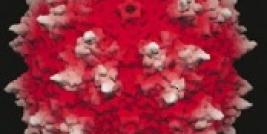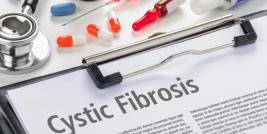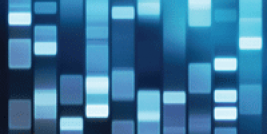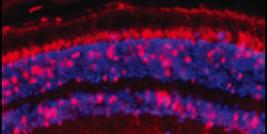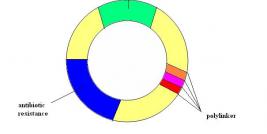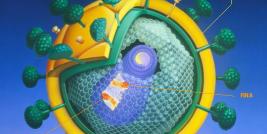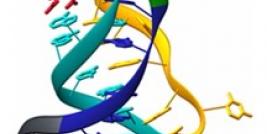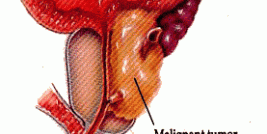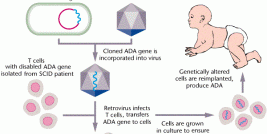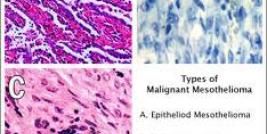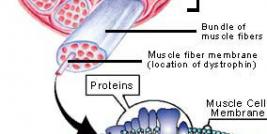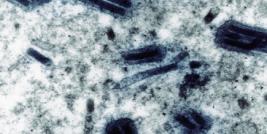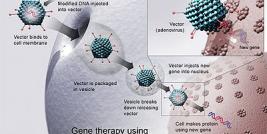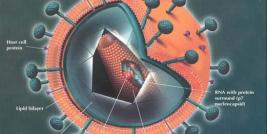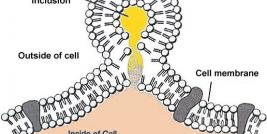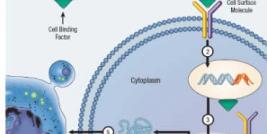NON VIRAL GENE THERAPY RESEARCH. Great progresses have been done with the aim of developing non viral procedures for gene transfer that would be safe and efficient. In this sense, we must remark the success obtained in:
A) Nonviral Liver Gene Therapy. The liver is an organ of interest in gene therapy due to its associated hereditary pathologies and also because of its great size, which makes him a good candidate as host organ for the production of the substances that could have interest in substitutive therapeutics. Maximal success has been achieved in little animals, that is, liver production of exogenous human genes, at therapeutic and long-term levels (>6 months), also with well tolerated dose-dependent responses. Today, the model is being validated in larger animals (pig) in order to optimize the procedure in models closer to the human conditions. Further on, there is a chronological citation of the main results obtained, easily identificable by their publication titles.
* Recombinant cDNA encapsulation in small liposomes with hepatocyte access ability. J. Microencapsulation 10:163-170, 1993.
* "In vivo" delivery of human a1-antitrypsin gene to mouse hepatocytes by liposomes. Biochem.Biophys.Res.Commun. 192:174-181, 1993.
* "Expression of human α1-antitrypsin in mouse after in vivo gene transfer to hepatocytes by small liposomes" Biochem.Biophys.Res.Commun. 204: 1023-1030, 1994
* Human α1-antitrypsin gene transfer to in vivo mouse hepatocytes. Human Gene Therapy. 7: 531-536 (1996)
* Asialofetuin liposome-mediated human alpha 1-antitrypsin gene transfer in vivo results in stationary long-term gene expression. J. Mol. Med. 79: 205-212 (2001)
* Long-term therapeutic levels of human alpha1-antitrypsin in plasma after hydrodynamic injection of nonviral DNA.Gene Therapy 10: 1672-1679 (2003)
* Hydrodynamic liver gene transfer mechanism involves transient sinusoidal blood stasis and massive endocytic vesicles. Gene Therapy 12: 927-935 (2005)
* Mouse and pig nonviral liver gene therapy: success and trials. Gene Therapy and Molecular Biology 9: 169-180 (2005)
* Hydrodynamic liver gene transfer mechanism involves transient sinusoidal blood stasis and massive endocytic vesicles. Gene Therapy 12: 927-935 (2005)
* Mouse and pig nonviral gene therapy: success and trials.
Gene Ther Mol Biol 9: 169-180 (2005). Electronic journal(www.gtmb.org)
* Pig liver gene therapy by non invasive interventionist catheterism. Gene Therapy 14: 334-343 (2007)
B) Nonviral Cancer Gene Therapy. By using non virally genetically modified tumor cells, we have developed antisense and antiangiogenic strategies as well as preventive vaccines, in this case with 100% survival efficacy in animal models. The main success has been achieved using cellular genetic vaccines. The vaccinated animals develop cell memory, effective against the tumor, which is confirmed when the survival animals reject again the tumor one year after the first treatment, when they are administered one recall vaccine dose. We are optimizing this vaccine in order to obtain good efficacies when used for therapeutic treatment (therapeutic vaccines), which have an obvious clinical interest. At present, we have partially demonstrated their efficacy. Further on, there is a chronological citation of the main results obtained, easily identificable by their publication titles.
* Oligonucleotide-entrapped immunoliposome delivered by mini-osmotic pump improves the survival of scid mice bearing human leukemia. Tumor Targeting 4: 1-9 (1999)
* Stability of PEI/DNA and DOTAP/DNA complex: effect of alkaline pH, heparin and serum. Journal of Contolled Release: 76: 169-181 (2001)
* Antitumor effect of B16 melanoma cells genetically modified with the angiogenesis inhibitors RNasin. Cancer Gene Ther.: 8: 278-284 (2001)
* Polyethyleneimine based immunopolyplex for targeted gene transfer in human lymphoma cell line. Journal of Gene Medicine.: 4: 170-182 (2002)
* Complete tumor prevention by engeneered tumor cell vaccines employing non viral vectors. Cancer Gene Therapy 10: 887-897 (2003)
* Antisense gene therapy using anti-k-ras and antitelomerase oligonucleotides in colorectal cancer. Rev Esp Enferm Dig 97: 472-480 (2005)
* Moret-Tatay I., Sanmartin I., Marco F.M., Díaz J. Aliño, S. F. Nonviral therapeutic cell vaccine mediates potent antitumor effects. Vaccine 24: 3937-3945 (2006)
* Antigens and cytokine gene in antitumoral vaccines: the importance of the temporal delivery sequence in the antitumor signals. Ann. N.Y. Acad. Sci 1091: 412-424 (2006)
* Bead-selected antitumor genetic cell vaccines. Clinical Medicine: Oncology, 2: 257-265 (2008)
* Effects of anti-K-Ras and Anti-Telomerase Phosphorothioate Antisense Oligonucleotides on Colorectal Cancer Growth. In Antisense Elements (Genetics) Research Focus. Gustafsson WB Ed. New York: Nova Publishers, 2008, pp 1-18 ISBN:1-60021-969-1
* Non viral cancer vaccines: from free antigens to engineered cells. In New gene therapy and cancer research. Gustafsson WB Ed. New York: Nova Publishers, 2008 ISBN:1-60021-969-1
C) Design of Nonviral Genes as Medicines. The optimization of the gene transfer by nonviral procedures has lead to the development and characterization of vectors. For that purpose, we have introduced the pharmacological concepts of Potency, Efficacy and Intrinsic Activity with the aim of defining the genes as medicines using objective criteria. Further on, there is a chronological citation of the main results obtained, easily identificable by their publication titles.
* Long-term expression of the human α1-antitrypsin gene in mice employing anionic and cationic liposome vectors. Biochem. Pharmacol. 51: 1309-1314, 1996
* Commentary: Long-term expression of the human a1-antitrypsin gene in mice employing anionic and cationic liposome vector. Biochem. Pharmacol. 54: 9-13, (1997)
* Pharmacokinetics of oligodeoxynucleotides encapsulated in liposomes: effect of lipid composition and preparation method.. Xenobiotica 29: 1283-1291 (1999)
* Pharmacodynamic approach to study the gene transfer process employing non-viral vectors. Biochem. Pharmacol.60: 1845-1853 (2000)
* Targeted Oligonucleotide delivery in human lymphoma cell lines using polyethyleneimine based immunopolyplex. Journal of Controlled Release 83: 133-146 (2002)
* Asialofetuin liposomes for receptor-mediated gene transfer into hepatic cells. In Methods in Enzymology: Liposomes. Ed. N Düzgünes. Methods in Enzymology 373: 399-421 (2003)
* Transfection pathways of non-specific and targeted PEI-polyplexes. Gene Therapy and Molecular Biology 8: 369-384 (2004)
Development of human diagnostic/prognostic genetic test
A) Development of the quantitative RT-PCR analysis of the telomerase gene (hTERT) in cancer patients plasma, with the aim of evaluating its diagnostic and/or prognostic interest as a universal test for tumor presence. Its utility has been confirmed best in colorectal and prostate cancer. Further on, there is a chronological citation of the main results obtained, easily identificable by their publication titles.
* Real-time quantification in plasma of human telomerase reverse transcriptase (hTERT) mRNA: a simple method blood test to monitor disease in cancer patients. Lab. Invest. 81: 767-769 (2001)
* Real time quantification in plasma of human telomerase reverse transcriptase (hTERT) mRNA in patients with colorectal cancer. Colorectal Disease 6: 236-242 (2004)
* Cytokine expresión and dendritic cell density in melanona sentinel nodes. Melanona Research 15: 99-106 (2005)
* Dasí F, Martínez-Rodes P, March JA, Santamaría J, Martínez-Javaloyas JM, Gil M, Aliño SF. Real time quantification of human telomerase reverse transcriptase mRNA in the plasma of patients with prostate cancer. Ann. N.Y. Acad. Sci 888: 1-7 (2006)
B) Pharmacogenetic/Pharmacogenomic of immunossupresor drugs in transplanted patients.
Educational Gene Therapy
- Course of Advanced Gene Therapy for Doctoral students
- Course of Gene Therapy for students of the last years of Medical degree
- Course of Gene Therapy for students of the last years of Pharmacy degree
- Coordinator of Meetings on Human Genome and Gene Therapy

